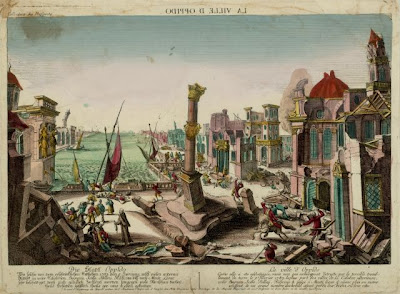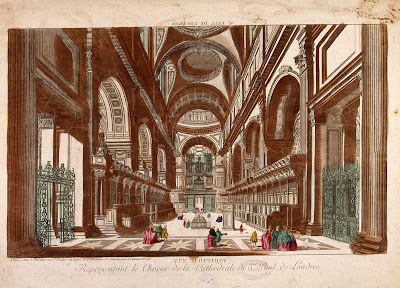In March,
I told you about a show I've been working on for the summer season, The Art of Peril: Fires, Shipwrecks, and other Disasters. In that post, I told you about the explosion of the Peacemaker,
one of several historical disasters I’m featuring.
Today I’ll share with you another catastrophe I’ve been learning about, a series of earthquakes that occurred in Italy at the end of the 18th century.
On February 5, 1783, the first of a series of earthquakes struck the southern tip of Italy. Over a period of two months, five earthquakes and hundreds of aftershocks were recorded, triggering tsunamis. By the time the tremors ended, hundreds of towns and villages had been destroyed, and the death toll was estimated between 30,000 and 60,000. Many deaths resulted from disease and poor sanitary conditions. To put that number in perspective, imagine having the entire population of Burlington, Vermont, which was estimated to be around 42,500 in 2012, wiped out during the course of spring mud season.
Today I’ll share with you another catastrophe I’ve been learning about, a series of earthquakes that occurred in Italy at the end of the 18th century.
On February 5, 1783, the first of a series of earthquakes struck the southern tip of Italy. Over a period of two months, five earthquakes and hundreds of aftershocks were recorded, triggering tsunamis. By the time the tremors ended, hundreds of towns and villages had been destroyed, and the death toll was estimated between 30,000 and 60,000. Many deaths resulted from disease and poor sanitary conditions. To put that number in perspective, imagine having the entire population of Burlington, Vermont, which was estimated to be around 42,500 in 2012, wiped out during the course of spring mud season.
Here’s a print that shows one of those quakes wreaking havoc on a port city.
 |
| Artist Unknown, La Ville d'Oppido, late 18th century, hand-colored engraving. Collection of Shelburne Museum, 27.6.2-93 |
What you’re looking at is an example of a vue d’optique, or “optical view,” a type of engraving that shows three-dimensional views of different places. Think of these as an ancestor of 3D movies. They’re ideally viewed through a device called a zograscope, which consists of a magnifying lens and a mirror mounted to a stand.
 |
|
A zograscope and vue d’optique. Image
courtesy of
http://www.georgianprints.co.uk/typesofprints/Zograscope/zograscope.html
|
To enjoy the 3D
nature of the vue d’optique, you place the print under the magnifying lens,
which amplifies the print’s sense of perspective, and then look at
its reflection in the mirror. These prints were often hand-painted in bright,
almost garish colors, which helped enhance their 3D qualities.
Shelburne Museum has several of these, actually. Here are two examples:
 |
| J. Chereau, St. Paul de Londres (St. Paul's Cathedral, London), 18th century, hand colored engraving. Collection of Shelburne Museum. |
 |
| Artist Unknown, Vue de Louvre (View of the Louvre), 18th-early 19th century, hand colored engraving. Collection of Shelburne Museum |
Vue d’optiques often
depict placid scenes of famous cities, but the one I’m featuring is all about destruction.
What struck me about this print was not so much the overall composition or its technical skill (vue d’optiques typically aren’t the most skillfully-executed engravings), but the vignettes sprinkled throughout the piece. Let’s look at some of these scenes.
On the left side of the print (or proper right in art conservation terms), a priest appears to give last rites to a dying man.
Meanwhile, in the
lower right side of the print, another man is crushed beneath broken
masonry.
Then there’s this man, who could be shielding himself from
some falling debris, throwing his arms up in despair, or both.
I’m not claiming that this print is an objective visual record of the earthquakes. The poses are conventional and the colors too conveniently synchronized for that. Still, these passages do remind me that real people suffered and died from these tremors. I think we sometimes forget this as an event becomes more distanced from us chronologically, but we should remember the suffering that these people experienced when we look at images like these. They’re fun to look at, but they’re also sobering.




